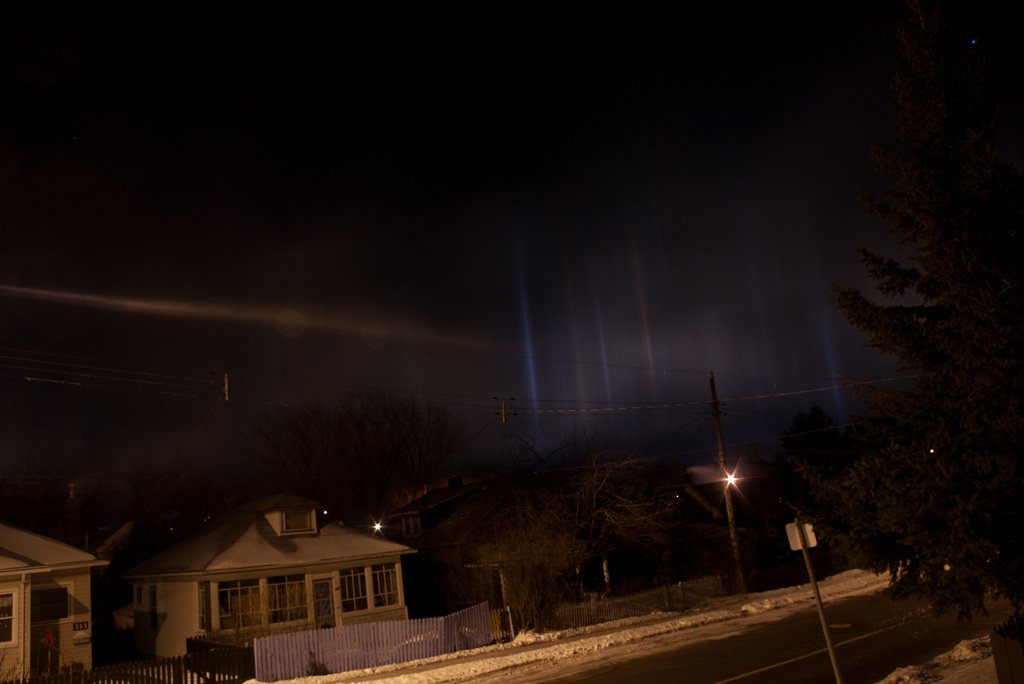What would you think if you were walking along an icy road on a cold night and suddenly you saw bright, colorful light beams stretching up in the sky?

(Image source - author, Christoph Geisler - license)
1. X-files alien abduction?
2. Star War light saber battles?
3. Ice crystals?
And if you've been following my posts for quite some time, you'd already know that the right answer is number...3, ice crystals!
Ice doesn't have a color and it doesn't glow
Sure yeah, but ice crystals work like prisms and refract light, they also work like mirrors and reflect light and this is what the mysterious lights are all about.

(Image source - author, Boweruk - license)
Refraction-reflection, help me a little
Refraction is when a ray of light enters a medium and bends (changes direction) but manages to pass through, remember prisms? Reflection is when a ray of light hits on a medium and bounces back (once again changes direction), like mirrors. When light hits on an ice crystal, some of it will be refracted and the rest will be reflected. The extend of these functions, the orientation of the crystals and the place where these happen will define the final optical illusion we'll see.

(Image source - author, Kyle Simpson - license)
Mirror mirror in the sky light a beam that gets so high
When the weather is extremely cold (temperatures below 0 degrees Celsius), water vapor in the atmosphere forms tiny ice crystals in very low altitudes (closer to the ground). They are then known as diamond dust (only they're not worth as much as real diamond dust). These crystals interact with sunlight coming from or even under the horizon (and then the phenomenon is called solar or sun pillar), moonlight (that gives us lunar pillars) or even artificial light (streetlights). These crystals are usually hexagonal and flat-shaped and fall horizontally, parallel to the ground. They reflect the rays of light that hit onto them, like tiny floating mirrors. When the crystals are tilted by turbulence in the atmosphere, the phenomenon is enhanced and the result is long light beams that lead all the way up to the sky. The cool thing is that the crystals don't have to hover right above the source of light, they work by accumulating reflection beams to create this wonderfully bright (got the pun?) spectacle.

(Image source - author, V1adis1av - license)
Where can I see them?
Since you need really cold temperatures, you can mostly view light pillars in places where temperatures like to lie below zero, so all the requirements for their appearance are met. Canada and Sweden and Alaska are some of the best places to go if you want to witness that.
Is it like the aurora thing?
No, the aurora phenomenon has to do with the magnetic field of the earth and its interaction with solar wind (plasma). This phenomenon is way different. It's caused by the interaction of light with ice crystals (no plasma included) and it's part of a wider family of light illusions called halos. Whereas the color of the aurora lights depends on the atmospheric element that gets excited by solar wind particles, the color of a light pillar depends on the original color of the reflected light beam.
Check this short video for a quick revision:
References
sciencealert.com
wikipedia.org
accuweather.com
timeanddate.com
housebeautiful.com

Thank you for stopping by and giving this post a read. I hope you enjoyed it! If it got your curiosity-radar on, you can check some of the previous articles on this series:
24 - Ball Lightning
25 - Moeraki Boulders
26 - Psychedelic Swamp
27 - Supercell Storms
28 - Northern Lights
If you please, feel free to pay a visit to my blog and check out my short stories along with plenty of educational posts and of course lots of doses of troll-teaching!


Until my next post,
Steem on and keep smiling, people!


